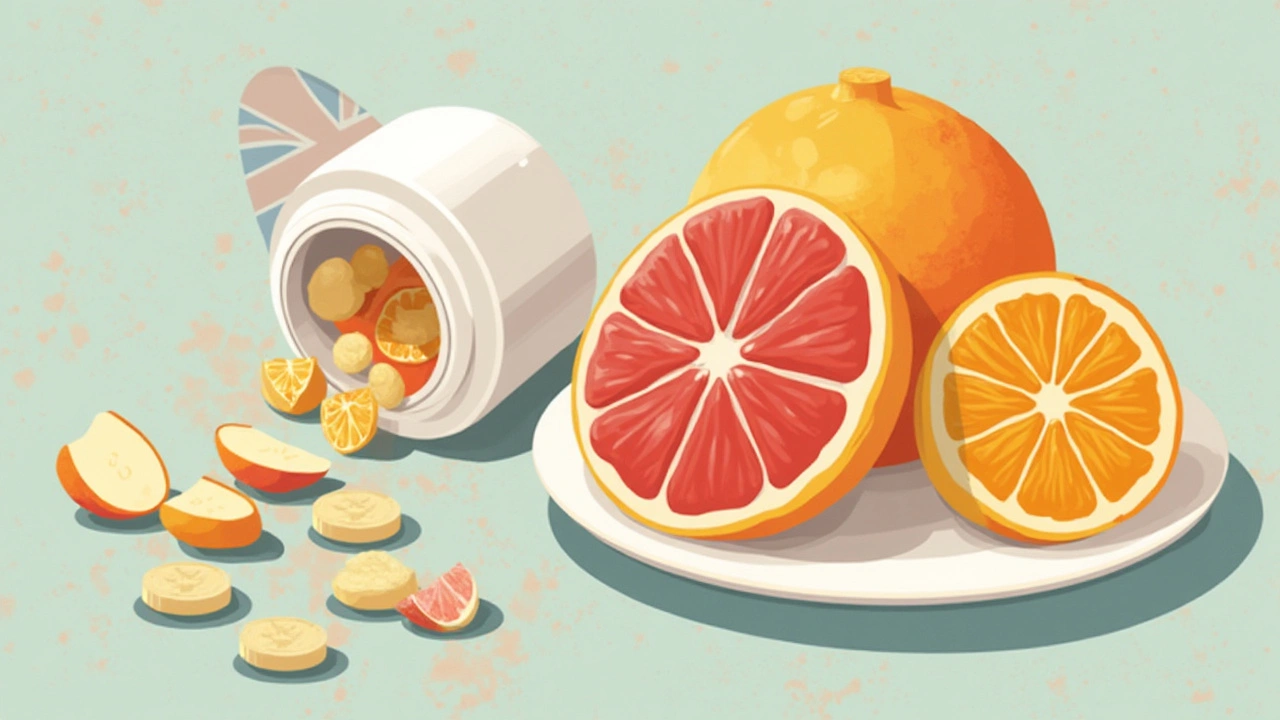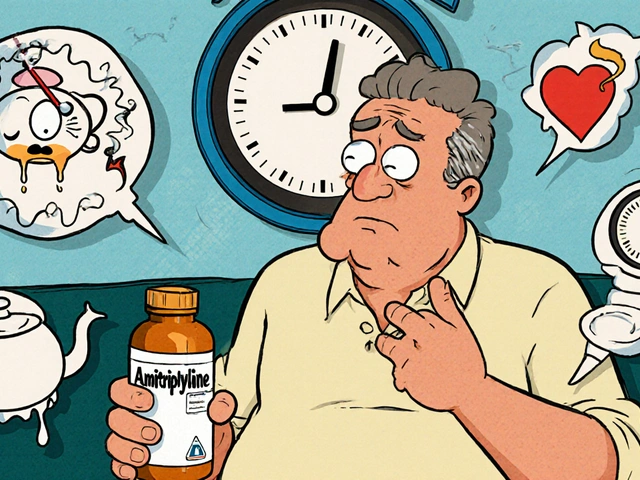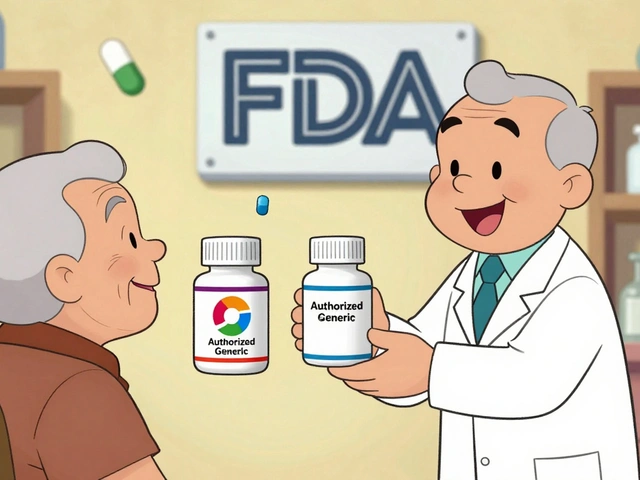The Surprising Problem with Grapefruit and Cholesterol Meds
Here’s something most people never hear from their pharmacist: grapefruit and cholesterol medication can be a risky combo. The shocker? One serving of grapefruit—or even a glass of juice—can mess with how your body handles some popular statins like atorvastatin and simvastatin. Why does this citrus get singled out when other fruits don’t even get a warning? It comes down to a group of enzymes in your gut called CYP3A4. Grapefruit, and to a lesser extent, some related fruits like Seville oranges, inhibit these enzymes—with the effect that your statin can build up in your blood. This makes side effects like muscle pain, weakness, and even rare muscle breakdown way more likely.
Nobody’s saying that a single slice on your salad spells disaster for everyone. But there’s a world of difference between the odd segment and downing large amounts daily. Studies have shown as little as one whole grapefruit or a 200 mL glass of grapefruit juice can be enough to double or triple the blood levels of some statins. Not everyone’s body reacts exactly the same, but you don’t want to play Russian roulette with your cholesterol meds—especially since side effects might not give you much warning. That’s why most U.S. pharmacies and doctors will tell you to avoid grapefruit altogether if you’re on certain cholesterol-lowering drugs.
Here’s one fact that’s often buried: it’s really the furanocoumarins in grapefruit causing the trouble. These natural compounds block the enzyme pathway. Other fruits like orange, lemon, and tangerine don’t have this problem. Pomelo and tangelo come close (they’re distant cousins of grapefruit), but most regular oranges are fine.
Your prescription bottle’s tiny sticker can’t tell you how much is safe, but researchers have tried to nail it down. One study in the "British Journal of Clinical Pharmacology" showed that even 200-250 mL of juice (about ¾ cup) increases statin blood levels by up to 80%. And a meta-analysis found that for people on atorvastatin, drinking grapefruit juice daily for just a few days led to a twofold increase in drug levels. That’s pushing you right into the zone where liver and muscle damage become a real risk.
How Much Grapefruit Crosses the Line?
Let’s get precise. The U.S. Food and Drug Administration and the Canadian Heart and Stroke Foundation warn that even small amounts can cause an issue if you’re taking drugs like atorvastatin, simvastatin, or lovastatin. One whole grapefruit, or a single eight-ounce (250 mL) juice glass, is enough to trigger the effect. It doesn't matter if you spread it out during the week—the enzyme-blocking impact can linger for 24-72 hours. That means the "grapefruit hit" you get from breakfast could still be messing with your medication two days later.
This isn’t just a U.S. thing. Health agencies in Europe, Australia, and across Asia all put out the same warning: the interaction is not dose-dependent in a safe way. Your gut either blocks the statin metabolism or it doesn’t—there isn’t really a “safe” daily intake for most people on these meds. If you’re looking for a hard number, clinical guidance usually comes down to zero. Sure, some specialists say an occasional small wedge is probably ok, but nobody wants to be the experiment.
For people who absolutely crave the taste, here are some practical tips: never drink a full glass of juice, avoid eating the fruit on consecutive days, and steer clear of products like marmalade that use Seville or bitter oranges. One study in Taiwan found the risk of interactions went up even with as little as ¼ of a grapefruit. If your kids (like Theo and Sabina at my house) swipe a wedge off your plate now and then, they’re safe. But for anyone on medication, it’s smarter to keep grapefruit on the forbidden list.
At this point, some folks wonder if the same rules apply for all statins. The answer: not really. Drugs like pravastatin or rosuvastatin don’t use the CYP3A4 pathway as much, so grapefruit is less likely to cause issues with those. But since meds change over time, and pharmacists can switch generic brands, it’s safer to ask every time you get a refill. This link does a good job breaking down how much grapefruit is safe with atorvastatin by showing the latest interactions and risks—give it a look if you’re on or considering switching statins.
Bottom line: if your statin label lists grapefruit as a warning, treat even small amounts as potentially risky. There’s no medal for skirting the edge, especially considering the headache of side effects.

Best Timing Strategies If Grapefruit Slips In
Caught yourself with a bite of grapefruit before remembering your medication? Don’t panic, but timing can help reduce the risk. Let’s get one thing clear: the chemical interaction sticks around a lot longer than most people think. Unlike alcohol, which you can "wait out," the enzyme-inhibiting effect from grapefruit can linger up to three days. That means planning your statin dose and your fruit cravings on separate days doesn’t always shield you.
If you slipped up with a single small serving of grapefruit, skip your statin dose immediately and call your doctor or pharmacist. They’ll help decide if you need to skip, delay, or continue your medication. Repeated slip-ups are riskier. Avoid the temptation to "double up" on doses or go back to your normal routine without advice—this can overload your system with the drug and send those side effects into overdrive.
If you frequently crave citrus or eat out where grapefruit shows up in dressings or desserts, get in the habit of asking before you order. It takes a little awkwardness to avoid a bigger health problem. I’ve trained my kids to check with waiters when they eat at grandparents’—because one time Theo shared a grapefruit slice in a fancy salad, and I realized how common it is as a hidden ingredient.
Some resources also suggest timing your statin at night, since your liver makes cholesterol overnight and you’re less likely to have eaten grapefruit before bed. But the enzyme-blocking effect still lingers, so don’t rely on this timing as magic protection. The best timing strategy really is to avoid grapefruit altogether if your statin is on the problem list. If you think the fruit managed to sneak in somewhere, jot down the time, amount, and how you feel—then let your provider know.
There’s another pro tip a lot of people miss: check your supplement ingredients. Some multivitamins, flavored waters, and herbal products use “natural citrus extract” or “grapefruit flavor”—read the tiny print at the end of the label. Even a small accidental hit can add up if you’re a regular statin user. It’s usually not enough to cause disaster, but being vigilant is better than being sorry.
Fruit Alternatives That Don’t Mess with Statins
Good news: you don’t have to ditch all citrus or fruit just because you’re taking cholesterol medication. In fact, most nutritionists encourage at least five servings of fresh fruit and veggies daily for heart health. Let’s break down the best swaps if you miss the tangy taste of grapefruit.
- Oranges and tangerines: Both are safe for statin users—no CYP3A4 block to worry about. If you like sour treats, blood oranges deliver a slightly more tart punch and are loaded with antioxidants.
- Lemons and limes: None of the enzyme issues here, and they’re perfect for squeezing into water, over salads, or as zest for baking.
- Pineapple: It’s sweet, tangy, and full of vitamin C—plus, it pairs with both savory and sweet dishes.
- Kiwi: Surprising, but it’s loaded with fiber, and that tartness can stand in nicely for grapefruit in recipes.
- Berries: Raspberries, blueberries, and blackberries have heart-healthy benefits and don’t mess with cholesterol drugs.
Some folks swear by pomelo, but this one is closely related to grapefruit and should only be eaten in small, monitored amounts (and only after you’ve double-checked with your doctor). Even marmalades or juices that sound “tart” may hide grapefruit juice in the ingredients—always scan the product label.
If breakfast feels a little dull without that grapefruit routine, try the combo of orange slices and strawberries for a similar “wake up” effect. You can even add a sprinkle of chili powder and salt for an extra zing—Theo and Sabina turned their noses up the first time, but now it’s their favorite after-school snack.
The old advice about “taking statins at bedtime so you can have grapefruit in the morning” doesn’t work with today’s long-acting drugs. Most statins like atorvastatin “hang out” in your system for days, so swapping fruit is safer than spinning the timing wheel. Don’t forget: fresh fruit still beats processed snacks in every nutrition contest.

Talking to Your Doctor and Staying Safe With Statins
It’s easy to feel overwhelmed by all the dietary rules that come with a new prescription. But talking straight to your doctor or pharmacist about grapefruit and cholesterol medication saves you a whole lot of guesswork. Most people assume doctors bring this up automatically, but it doesn’t always happen—especially if you refill at a different pharmacy or get a generic brand one month and a different one the next.
Bring a full list of the fruits and supplements you eat regularly. If you love anything sour, tangy, or citrusy, ask specifically about its safety. Sometimes you can switch to a statin with lower risk (like pravastatin) if you really can’t stand the idea of missing grapefruit forever. For those on meds like simvastatin, atorvastatin, or lovastatin, expect your doctor to recommend an alternative fruit 100% of the time.
It’s smart to keep a health diary the first month you take a new statin, especially if you’re experimenting with diet changes. List symptoms such as muscle soreness, new joint pain, or any stomach distress—this will help your doctor pinpoint if you’re having a reaction, and if fruit might be playing a role. If you ever feel weak, confused, or notice dark urine (a rare sign of muscle breakdown), get medical help fast.
Be picky about reading labels—not just on foods, but drinks and even supplements. Many multivitamins and “boost” beverages toss in a bit of citrus extract or flavor that isn’t always clearly labeled as grapefruit. At my place, we check nutrition panels with the same energy we use for tracking who’s eaten the last granola bar (Sabina usually, if you’re curious). Sounds intense, but it sure beats an ER visit.
Knowledge beats fear. When in doubt, contacts like the National Lipid Association, regional heart-health organizations, and quality medical info sites make it much easier to stay up to date on what’s safe and what isn’t. Never be embarrassed to double-check your fruit choices—your health is worth it.
| Fruit | Safe with Statins? | Comments |
|---|---|---|
| Grapefruit | No | Raises statin levels, avoid completely |
| Oranges/Tangerines | Yes | No CYP3A4 interaction |
| Lemons/Limes | Yes | Safe, all statins |
| Pomelo | Caution | Possible mild interaction, ask doctor |
| Pineapple | Yes | No interaction |
| Berries | Yes | Safe and heart-healthy |
Statin side effects pop up more often when diet and meds clash—so it’s worth taking a little time to get this balance right. Who knew that skipping a grapefruit could help your entire treatment plan run smoother?







Manish Mehta
May 1, 2025 AT 08:36Muzzafar Magray
May 2, 2025 AT 21:13Jackie R
May 3, 2025 AT 15:18Renee Williamson
May 5, 2025 AT 00:23Alexander Ståhlberg
May 6, 2025 AT 10:24